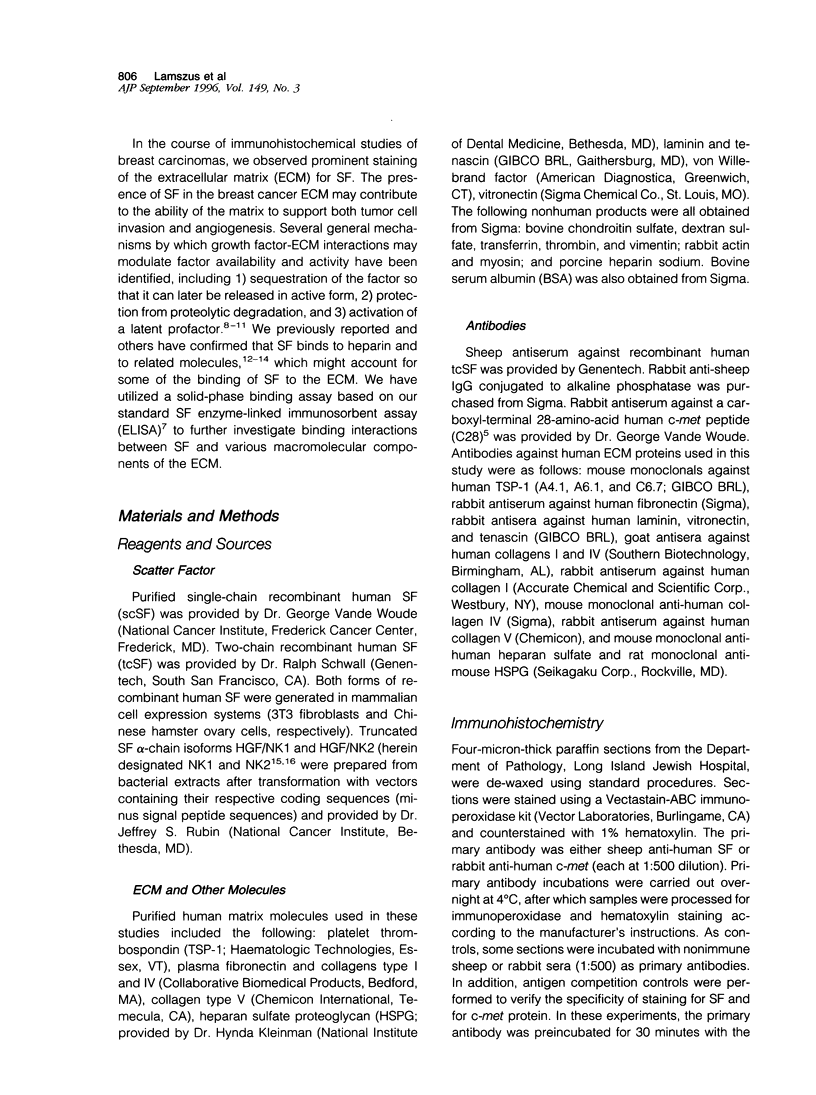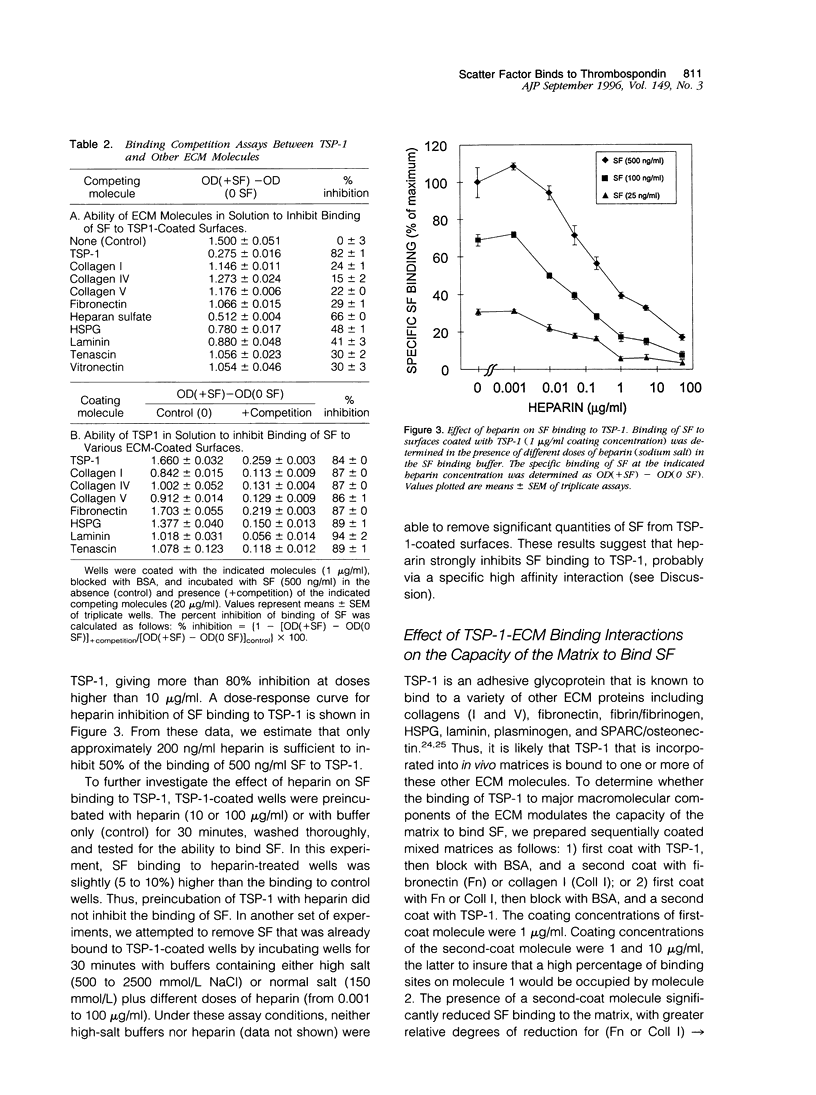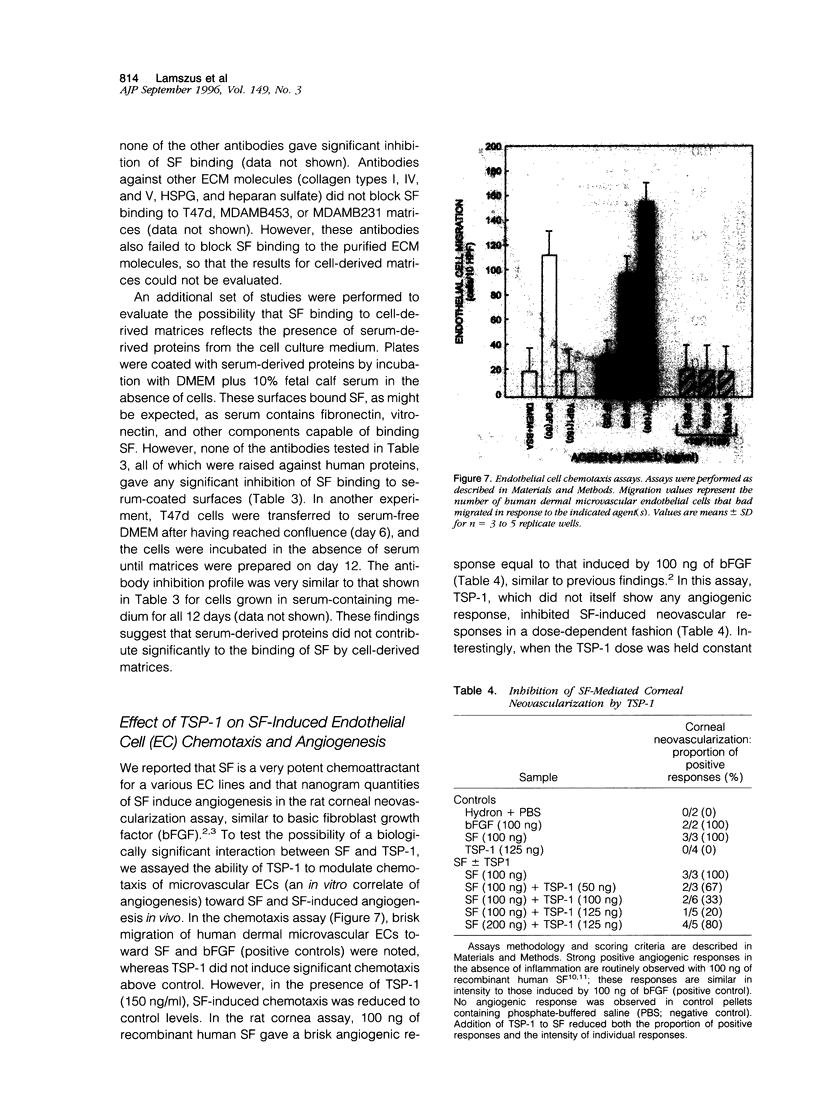Abstract
Scatter factor (SF) is an angiogenic growth factor that stimulates motility and invasion of carcinoma cells. SF is present in the extracellular matrix (ECM) of breast cancers, where it might act to promote tumor cell invasion and angiogenesis. To investigate how SF is incorporated into the ECM, we studied the binding of SF to various ECM components using a solid-phase binding assay based on the SF enzyme-linked immunosorbent assay. We found that SF binds to a variety of ECM molecules, with different binding capacities. The highest SF binding capacities were observed for thrombospondin-1 (TSP-1), fibronectin (Fn), and heparan sulfate proteoglycan, although SF did not bind to albumin. Mature two-chain SF and precursor single-chain SF bound approximately equally well to TSP-1 and Fn. Moreover, two SF alpha-chain peptides (NK1 and NK2) both bound to TSP-1 and Fn, suggesting that the whole SF molecule is not required for binding. Based on binding competition assays, TSP-1 exhibited higher affinity for SF than did nine other ECM molecules, including Fn and heparan sulfate proteoglycan. Although heparin in solution potently inhibited the binding of SF to TSP-1-coated surfaces, even very high concentrations of heparin could not elute SF already bound to TSP-1. SF binding was modulated by binding interactions among ECM molecules (TSP-1-Fn, TSP-1-collagen I, and Fn-collagen I), suggesting that the matrix capacity to bind SF depends upon its exact composition. SF bound in a dose-dependent fashion to ECMs secreted by three human breast carcinoma cell lines. Binding of SF to matrices from all three cell lines was significantly inhibited by preincubation of the matrices with antibodies against TSP-1, whereas antibodies against several other ECM components were less effective or ineffective in inhibiting SF binding. In addition, TSP-1 markedly inhibited chemotaxis of microvascular endothelial cells toward SF and SF-induced angiogenesis in the rat cornea neovascularization assay. Our findings suggest that 1) SF interacts with a variety of ECM components, 2) high affinity SF-TSP-1 interactions may mediate the binding of SF to the breast cancer matrix, and 3) the SF-TSP-1 interaction may contribute to modulation of angiogenesis. Possible implications of these findings for tumor angiogenesis are discussed.
Full text
PDF














Images in this article
Selected References
These references are in PubMed. This may not be the complete list of references from this article.
- Benezra M., Vlodavsky I., Ishai-Michaeli R., Neufeld G., Bar-Shavit R. Thrombin-induced release of active basic fibroblast growth factor-heparan sulfate complexes from subendothelial extracellular matrix. Blood. 1993 Jun 15;81(12):3324–3331. [PubMed] [Google Scholar]
- Bornstein P. Diversity of function is inherent in matricellular proteins: an appraisal of thrombospondin 1. J Cell Biol. 1995 Aug;130(3):503–506. doi: 10.1083/jcb.130.3.503. [DOI] [PMC free article] [PubMed] [Google Scholar]
- Bottaro D. P., Rubin J. S., Faletto D. L., Chan A. M., Kmiecik T. E., Vande Woude G. F., Aaronson S. A. Identification of the hepatocyte growth factor receptor as the c-met proto-oncogene product. Science. 1991 Feb 15;251(4995):802–804. doi: 10.1126/science.1846706. [DOI] [PubMed] [Google Scholar]
- Chan A. M., Rubin J. S., Bottaro D. P., Hirschfield D. W., Chedid M., Aaronson S. A. Identification of a competitive HGF antagonist encoded by an alternative transcript. Science. 1991 Nov 29;254(5036):1382–1385. doi: 10.1126/science.1720571. [DOI] [PubMed] [Google Scholar]
- Clezardin P., Frappart L., Clerget M., Pechoux C., Delmas P. D. Expression of thrombospondin (TSP1) and its receptors (CD36 and CD51) in normal, hyperplastic, and neoplastic human breast. Cancer Res. 1993 Mar 15;53(6):1421–1430. [PubMed] [Google Scholar]
- Clezardin P., Malaval L., Ehrensperger A. S., Delmas P. D., Dechavanne M., McGregor J. L. Complex formation of human thrombospondin with osteonectin. Eur J Biochem. 1988 Aug 1;175(2):275–284. doi: 10.1111/j.1432-1033.1988.tb14194.x. [DOI] [PubMed] [Google Scholar]
- Folkman J. The role of angiogenesis in tumor growth. Semin Cancer Biol. 1992 Apr;3(2):65–71. [PubMed] [Google Scholar]
- Good D. J., Polverini P. J., Rastinejad F., Le Beau M. M., Lemons R. S., Frazier W. A., Bouck N. P. A tumor suppressor-dependent inhibitor of angiogenesis is immunologically and functionally indistinguishable from a fragment of thrombospondin. Proc Natl Acad Sci U S A. 1990 Sep;87(17):6624–6628. doi: 10.1073/pnas.87.17.6624. [DOI] [PMC free article] [PubMed] [Google Scholar]
- Grant D. S., Kleinman H. K., Goldberg I. D., Bhargava M. M., Nickoloff B. J., Kinsella J. L., Polverini P., Rosen E. M. Scatter factor induces blood vessel formation in vivo. Proc Natl Acad Sci U S A. 1993 Mar 1;90(5):1937–1941. doi: 10.1073/pnas.90.5.1937. [DOI] [PMC free article] [PubMed] [Google Scholar]
- Guo N. H., Krutzsch H. C., Nègre E., Zabrenetzky V. S., Roberts D. D. Heparin-binding peptides from the type I repeats of thrombospondin. Structural requirements for heparin binding and promotion of melanoma cell adhesion and chemotaxis. J Biol Chem. 1992 Sep 25;267(27):19349–19355. [PubMed] [Google Scholar]
- Hofmann R., Joseph A., Bhargava M. M., Rosen E. M., Goldberg I. Scatter factor is a glycoprotein but glycosylation is not required for its activity. Biochim Biophys Acta. 1992 Apr 17;1120(3):343–350. doi: 10.1016/0167-4838(92)90258-f. [DOI] [PubMed] [Google Scholar]
- Joseph A., Weiss G. H., Jin L., Fuchs A., Chowdhury S., O'Shaugnessy P., Goldberg I. D., Rosen E. M. Expression of scatter factor in human bladder carcinoma. J Natl Cancer Inst. 1995 Mar 1;87(5):372–377. doi: 10.1093/jnci/87.5.372. [DOI] [PubMed] [Google Scholar]
- Kato S., Ishii T., Hara H., Sugiura N., Kimata K., Akamatsu N. Hepatocyte growth factor immobilized onto culture substrates through heparin and matrigel enhances DNA synthesis in primary rat hepatocytes. Exp Cell Res. 1994 Mar;211(1):53–58. doi: 10.1006/excr.1994.1058. [DOI] [PubMed] [Google Scholar]
- Kelly J. L., Sánchez A., Brown G. S., Chesterman C. N., Sleigh M. J. Accumulation of PDGF B and cell-binding forms of PDGF A in the extracellular matrix. J Cell Biol. 1993 Jun;121(5):1153–1163. doi: 10.1083/jcb.121.5.1153. [DOI] [PMC free article] [PubMed] [Google Scholar]
- Khachigian L. M., Chesterman C. N. Structural basis for the extracellular retention of PDGF A-chain using a synthetic peptide corresponding to exon 6. Peptides. 1994 Jan;15(1):133–137. doi: 10.1016/0196-9781(94)90181-3. [DOI] [PubMed] [Google Scholar]
- Koch A. E., Friedman J., Burrows J. C., Haines G. K., Bouck N. P. Localization of the angiogenesis inhibitor thrombospondin in human synovial tissues. Pathobiology. 1993;61(1):1–6. doi: 10.1159/000163752. [DOI] [PubMed] [Google Scholar]
- Masumoto A., Yamamoto N. Stimulation of DNA synthesis in hepatocytes by hepatocyte growth factor bound to extracellular matrix. Biochem Biophys Res Commun. 1993 Mar 31;191(3):1218–1223. doi: 10.1006/bbrc.1993.1347. [DOI] [PubMed] [Google Scholar]
- Mizuno K., Inoue H., Hagiya M., Shimizu S., Nose T., Shimohigashi Y., Nakamura T. Hairpin loop and second kringle domain are essential sites for heparin binding and biological activity of hepatocyte growth factor. J Biol Chem. 1994 Jan 14;269(2):1131–1136. [PubMed] [Google Scholar]
- Naka D., Ishii T., Shimomura T., Hishida T., Hara H. Heparin modulates the receptor-binding and mitogenic activity of hepatocyte growth factor on hepatocytes. Exp Cell Res. 1993 Dec;209(2):317–324. doi: 10.1006/excr.1993.1316. [DOI] [PubMed] [Google Scholar]
- Nakamura T., Nishizawa T., Hagiya M., Seki T., Shimonishi M., Sugimura A., Tashiro K., Shimizu S. Molecular cloning and expression of human hepatocyte growth factor. Nature. 1989 Nov 23;342(6248):440–443. doi: 10.1038/342440a0. [DOI] [PubMed] [Google Scholar]
- Naldini L., Weidner K. M., Vigna E., Gaudino G., Bardelli A., Ponzetto C., Narsimhan R. P., Hartmann G., Zarnegar R., Michalopoulos G. K. Scatter factor and hepatocyte growth factor are indistinguishable ligands for the MET receptor. EMBO J. 1991 Oct;10(10):2867–2878. doi: 10.1002/j.1460-2075.1991.tb07836.x. [DOI] [PMC free article] [PubMed] [Google Scholar]
- Nicosia R. F., Tuszynski G. P. Matrix-bound thrombospondin promotes angiogenesis in vitro. J Cell Biol. 1994 Jan;124(1-2):183–193. doi: 10.1083/jcb.124.1.183. [DOI] [PMC free article] [PubMed] [Google Scholar]
- Park J. E., Keller G. A., Ferrara N. The vascular endothelial growth factor (VEGF) isoforms: differential deposition into the subepithelial extracellular matrix and bioactivity of extracellular matrix-bound VEGF. Mol Biol Cell. 1993 Dec;4(12):1317–1326. doi: 10.1091/mbc.4.12.1317. [DOI] [PMC free article] [PubMed] [Google Scholar]
- Polverini P. J., Leibovich S. J. Induction of neovascularization in vivo and endothelial proliferation in vitro by tumor-associated macrophages. Lab Invest. 1984 Dec;51(6):635–642. [PubMed] [Google Scholar]
- Pratt D. A., Miller W. R., Dawes J. Thrombospondin in malignant and non-malignant breast tissue. Eur J Cancer Clin Oncol. 1989 Feb;25(2):343–350. doi: 10.1016/0277-5379(89)90028-x. [DOI] [PubMed] [Google Scholar]
- Raines E. W., Lane T. F., Iruela-Arispe M. L., Ross R., Sage E. H. The extracellular glycoprotein SPARC interacts with platelet-derived growth factor (PDGF)-AB and -BB and inhibits the binding of PDGF to its receptors. Proc Natl Acad Sci U S A. 1992 Feb 15;89(4):1281–1285. doi: 10.1073/pnas.89.4.1281. [DOI] [PMC free article] [PubMed] [Google Scholar]
- Rong S., Bodescot M., Blair D., Dunn J., Nakamura T., Mizuno K., Park M., Chan A., Aaronson S., Vande Woude G. F. Tumorigenicity of the met proto-oncogene and the gene for hepatocyte growth factor. Mol Cell Biol. 1992 Nov;12(11):5152–5158. doi: 10.1128/mcb.12.11.5152. [DOI] [PMC free article] [PubMed] [Google Scholar]
- Rosen E. M., Goldberg I. D., Kacinski B. M., Buckholz T., Vinter D. W. Smooth muscle releases an epithelial cell scatter factor which binds to heparin. In Vitro Cell Dev Biol. 1989 Feb;25(2):163–173. doi: 10.1007/BF02626174. [DOI] [PubMed] [Google Scholar]
- Rosen E. M., Goldberg I. D. Scatter factor and angiogenesis. Adv Cancer Res. 1995;67:257–279. doi: 10.1016/s0065-230x(08)60715-0. [DOI] [PubMed] [Google Scholar]
- Rosen E. M., Joseph A., Jin L., Rockwell S., Elias J. A., Knesel J., Wines J., McClellan J., Kluger M. J., Goldberg I. D. Regulation of scatter factor production via a soluble inducing factor. J Cell Biol. 1994 Oct;127(1):225–234. doi: 10.1083/jcb.127.1.225. [DOI] [PMC free article] [PubMed] [Google Scholar]
- Rosen E. M., Knesel J., Goldberg I. D., Jin L., Bhargava M., Joseph A., Zitnik R., Wines J., Kelley M., Rockwell S. Scatter factor modulates the metastatic phenotype of the EMT6 mouse mammary tumor. Int J Cancer. 1994 Jun 1;57(5):706–714. doi: 10.1002/ijc.2910570517. [DOI] [PubMed] [Google Scholar]
- Rosen E. M., Nigam S. K., Goldberg I. D. Scatter factor and the c-met receptor: a paradigm for mesenchymal/epithelial interaction. J Cell Biol. 1994 Dec;127(6 Pt 2):1783–1787. doi: 10.1083/jcb.127.6.1783. [DOI] [PMC free article] [PubMed] [Google Scholar]
- Schlessinger J., Lax I., Lemmon M. Regulation of growth factor activation by proteoglycans: what is the role of the low affinity receptors? Cell. 1995 Nov 3;83(3):357–360. doi: 10.1016/0092-8674(95)90112-4. [DOI] [PubMed] [Google Scholar]
- Schultz-Cherry S., Ribeiro S., Gentry L., Murphy-Ullrich J. E. Thrombospondin binds and activates the small and large forms of latent transforming growth factor-beta in a chemically defined system. J Biol Chem. 1994 Oct 28;269(43):26775–26782. [PubMed] [Google Scholar]
- Silverstein R. L., Leung L. L., Harpel P. C., Nachman R. L. Platelet thrombospondin forms a trimolecular complex with plasminogen and histidine-rich glycoprotein. J Clin Invest. 1985 Jun;75(6):2065–2073. doi: 10.1172/JCI111926. [DOI] [PMC free article] [PubMed] [Google Scholar]
- Silverstein R. L., Nachman R. L., Pannell R., Gurewich V., Harpel P. C. Thrombospondin forms complexes with single-chain and two-chain forms of urokinase. J Biol Chem. 1990 Jul 5;265(19):11289–11294. [PubMed] [Google Scholar]
- Swerlick R. A., Lee K. H., Wick T. M., Lawley T. J. Human dermal microvascular endothelial but not human umbilical vein endothelial cells express CD36 in vivo and in vitro. J Immunol. 1992 Jan 1;148(1):78–83. [PubMed] [Google Scholar]
- Taipale J., Miyazono K., Heldin C. H., Keski-Oja J. Latent transforming growth factor-beta 1 associates to fibroblast extracellular matrix via latent TGF-beta binding protein. J Cell Biol. 1994 Jan;124(1-2):171–181. doi: 10.1083/jcb.124.1.171. [DOI] [PMC free article] [PubMed] [Google Scholar]
- Taraboletti G., Roberts D., Liotta L. A., Giavazzi R. Platelet thrombospondin modulates endothelial cell adhesion, motility, and growth: a potential angiogenesis regulatory factor. J Cell Biol. 1990 Aug;111(2):765–772. doi: 10.1083/jcb.111.2.765. [DOI] [PMC free article] [PubMed] [Google Scholar]
- Tolsma S. S., Volpert O. V., Good D. J., Frazier W. A., Polverini P. J., Bouck N. Peptides derived from two separate domains of the matrix protein thrombospondin-1 have anti-angiogenic activity. J Cell Biol. 1993 Jul;122(2):497–511. doi: 10.1083/jcb.122.2.497. [DOI] [PMC free article] [PubMed] [Google Scholar]
- Tuszynski G. P., Nicosia R. F. Localization of thrombospondin and its cysteine-serine-valine-threonine-cysteine-glycine-specific receptor in human breast carcinoma. Lab Invest. 1994 Feb;70(2):228–233. [PubMed] [Google Scholar]
- Vlodavsky I., Korner G., Ishai-Michaeli R., Bashkin P., Bar-Shavit R., Fuks Z. Extracellular matrix-resident growth factors and enzymes: possible involvement in tumor metastasis and angiogenesis. Cancer Metastasis Rev. 1990 Nov;9(3):203–226. doi: 10.1007/BF00046361. [DOI] [PubMed] [Google Scholar]
- Wang Y., Selden A. C., Morgan N., Stamp G. W., Hodgson H. J. Hepatocyte growth factor/scatter factor expression in human mammary epithelium. Am J Pathol. 1994 Apr;144(4):675–682. [PMC free article] [PubMed] [Google Scholar]
- Weidner N., Folkman J., Pozza F., Bevilacqua P., Allred E. N., Moore D. H., Meli S., Gasparini G. Tumor angiogenesis: a new significant and independent prognostic indicator in early-stage breast carcinoma. J Natl Cancer Inst. 1992 Dec 16;84(24):1875–1887. doi: 10.1093/jnci/84.24.1875. [DOI] [PubMed] [Google Scholar]
- Weidner N., Semple J. P., Welch W. R., Folkman J. Tumor angiogenesis and metastasis--correlation in invasive breast carcinoma. N Engl J Med. 1991 Jan 3;324(1):1–8. doi: 10.1056/NEJM199101033240101. [DOI] [PubMed] [Google Scholar]
- Weinstat-Saslow D. L., Zabrenetzky V. S., VanHoutte K., Frazier W. A., Roberts D. D., Steeg P. S. Transfection of thrombospondin 1 complementary DNA into a human breast carcinoma cell line reduces primary tumor growth, metastatic potential, and angiogenesis. Cancer Res. 1994 Dec 15;54(24):6504–6511. [PubMed] [Google Scholar]
- Wong S. Y., Purdie A. T., Han P. Thrombospondin and other possible related matrix proteins in malignant and benign breast disease. An immunohistochemical study. Am J Pathol. 1992 Jun;140(6):1473–1482. [PMC free article] [PubMed] [Google Scholar]
- Yamashita J., Ogawa M., Yamashita S., Nomura K., Kuramoto M., Saishoji T., Shin S. Immunoreactive hepatocyte growth factor is a strong and independent predictor of recurrence and survival in human breast cancer. Cancer Res. 1994 Apr 1;54(7):1630–1633. [PubMed] [Google Scholar]
- Yoshinaga Y., Matsuno Y., Fujita S., Nakamura T., Kikuchi M., Shimosato Y., Hirohashi S. Immunohistochemical detection of hepatocyte growth factor/scatter factor in human cancerous and inflammatory lesions of various organs. Jpn J Cancer Res. 1993 Nov;84(11):1150–1158. doi: 10.1111/j.1349-7006.1993.tb02815.x. [DOI] [PMC free article] [PubMed] [Google Scholar]
- Zarnegar R., Muga S., Rahija R., Michalopoulos G. Tissue distribution of hepatopoietin-A: a heparin-binding polypeptide growth factor for hepatocytes. Proc Natl Acad Sci U S A. 1990 Feb;87(3):1252–1256. doi: 10.1073/pnas.87.3.1252. [DOI] [PMC free article] [PubMed] [Google Scholar]



